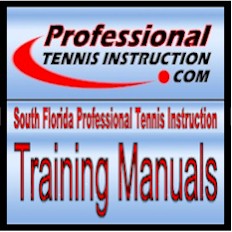|
Early Preparation
By: Andrew S. Rosz
South Florida Professional
Tennis Instruction
Hollywood, Florida , USA
(954) 922-8040
TECHNIQUES FOR EARLY PREPARATION
Note: As more fully described in the section on "General Techniques,"
TM1 refers to "from the waist up" and TM2 refers to "from the waist
down."
TM1 Techniques:
- Learn to react to the ball IMMEDIATELY once you hear the ball bounce off
your opponent's strings. This audible signal is your cue to begin turning sideways as
previously described in the "How to Watch the Ball" lesson.
- REACT QUICKLY, AND BRING YOUR RACKET BACK VERY SLOWLY AND IN A VERY
CONTROLLED MANNER. This will help you develop a very smooth backswing motion and also
allow you to maintain total awareness of your backswing. DO NOT CONFUSE REACTING QUICKLY
WITH WHIPPING YOUR RACKET BACK. You must maintain smoothness and control throughout the
entire backswing.
- Now more than ever, use a short concise backswing. Remember, TM1 only
provides 20% of the total backswing motion, TM2 provides the other 80%. Shortening your
backswing motion helps make learning early preparation easier and insures that TM1 won't
do more than its 20% share. (A very common error is to allow TM1 to do most of the
backswing work.)
- Once your backswing has reached its most extended backswing position,
WAIT FOR THE BALL WITH YOUR RACKET BACK. This technique of waiting for the ball with your
racket back is the first step in developing accurate and efficient only-forward, two-step
strokes.
- While waiting for the ball with your racket back, use your awareness
skills to check and adjust your racket pitch. This is your last chance to make sure that
you have the appropriate racket pitch for the type of shot that you are about to hit.
TM2 Techniques:
- TM2 and TM1 always react together when turning the body sideways. Do not allow TM2 to
react later than TM1; this will cause you to hit many of your shots in the open stance
position.
- The feet begin to move immediately as you begin to turn your body sideways. This makes
it easier to fulfill the 80% backswing requirement of TM2.
- Use TM2 to turn your body sideways when bringing your racket back. When waiting with
your racket back, TM1 should be comfortably facing four o'clock on forehands and eight
o'clock on backhands.
RECAP OF EARLY PREPARATION TECHNIQUES
TM1 Techniques:
- React immediately as the ball bounces off your opponent's strings
- Bring your racket back very slowly and with control
- Use a very short and concise backswing motion
- Wait for the ball with your racket back
- While waiting with your racket back, adjust your racket pitch
TM2 Techniques:
- TM2 and TM1 always react together when beginning to turn sideways
- Move your feet immediately when beginning to turn sideways
- Use TM2 to rotate your body to the four o'clock position on forehands (eight o'clock
position on backhands)

|
Note: Each of the tennis
tips outlined above are more fully discussed in a series of
expertly-written tennis instruction training manuals and book publications
for players who prefer to be "self-taught." For more
information on our world-renowned SFPTI tennis instruction
training manuals and book publications CLICK
HERE. |
Back
|